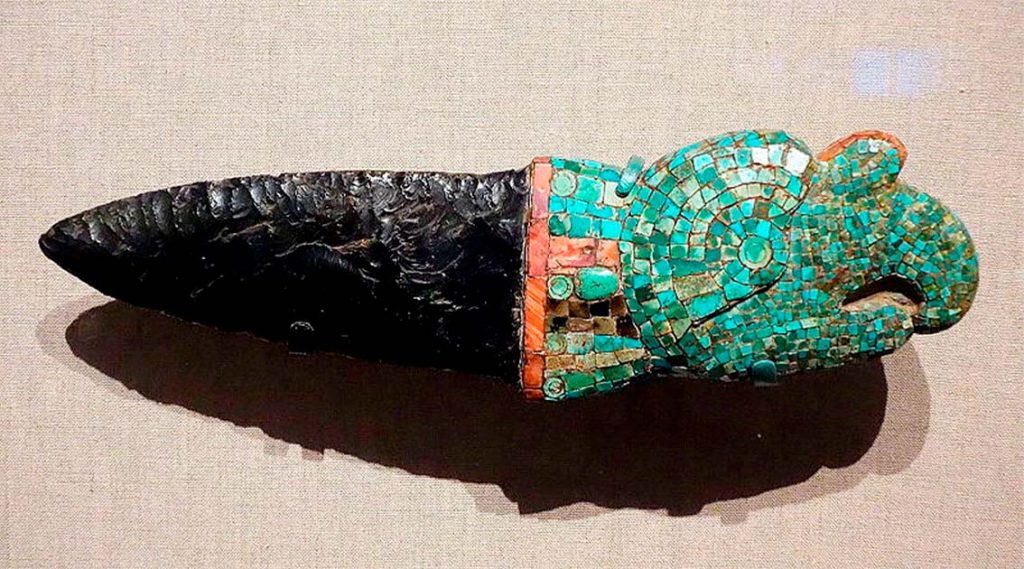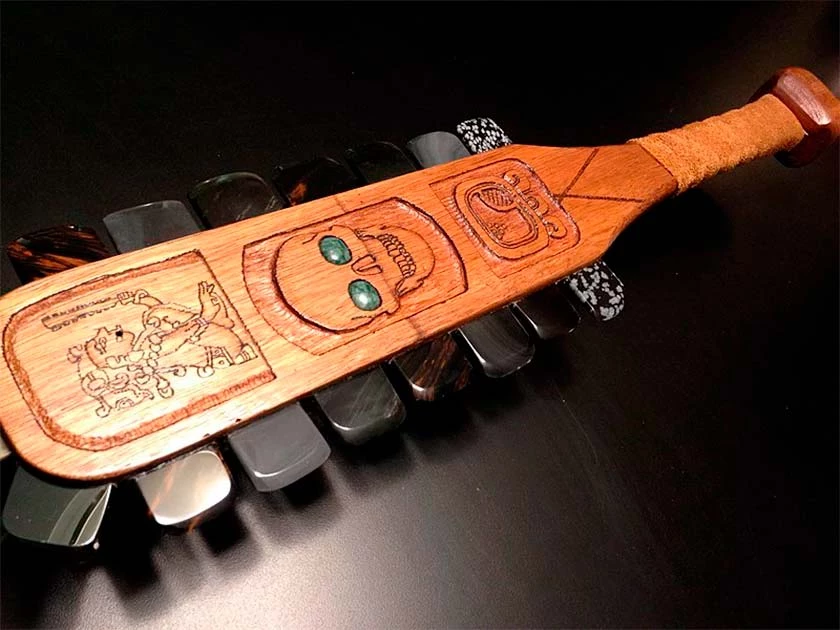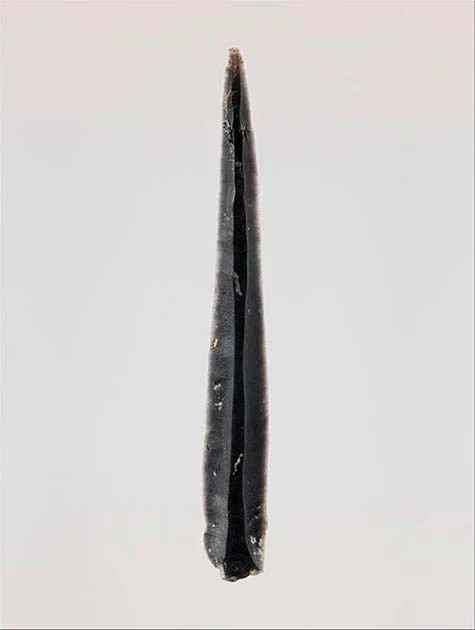One of the most fascinating ancient cultures was that of the Aztecs. They were incredibly advanced, yet in a very real sense of the phrase they remained stuck in the stone age.
While the world began to change with the adoption of bronze, brass, and steel for weapons, societies advanced. But the Aztecs did not readily adopt metal weapons. There was no need to.
The Aztec people had something sharper than steel, but which hurt less when the flesh was cut with it. The Aztecs had obsidian. The black volcanic glass glinted in the sun as battles were won with obsidian blades and shone with the warm wet blood from a sacrifice to the gods.
How was obsidian created, and who else used this unique material to make tools and weapons?
Obsidian
Put simply the Aztecs did not need to make obsidian: they just had to find it. Obsidian is a type of naturally occurring volcanic glass formed when lava released from a volcanic eruption rapidly cools with little to no crystal growth.
The kind of lava that produces obsidian is known as felsic lava. Felsic lava is rich in lightweight elements like oxygen, potassium, sodium, silicon, and aluminum. The presence of silica in the lava gives it a high viscosity level, preventing atoms in the lava from diffusing.
This atomic diffusion triggers the first step of mineral crystal formation, known as nucleation. The rapid rate at which the lava cools turns it into obsidian, a natural volcanic form of glass.
Obsidian is unique because it is considered to be “mineral-like,” but it is not a true mineral because it is glass, as opposed to crystalline material. The shiny black obsidian often seen in weapons is what is known as “pure obsidian”.
Still, the color will vary depending on what impurities like iron or magnesium are present in the lava. Obsidian can be dark green, brown, black, or mottled.

Nor it is particularly rare: you can find obsidian near volcanoes across the globe. Obsidian can be found everywhere from the United States to Scotland, New Zealand to Kenya.
- The Secret of Greek Fire: A Dark Age Flamethrower?
- Iron in the Bronze Age: Where did Tutankhamun get his Dagger?
Based on archeological evidence, it has been determined that obsidian was first used in Kariandusi (present-day Kenya), dating back to an astonishing 700,000 BC. Obsidian was used to create arrowheads and blades, known as bladelets, that were used to perform circumcisions and to cut a newborn’s umbilical cord since prehistoric times.
Obsidian is very brittle and hard, which allows it to easily break and fracture into sharp pieces. Primarily obsidian was a cutting or piercing tool, but it has also been used as a mirror, and experimental surgical scalpel blades have been created with obsidian.
The ancient Mesopotamian city of Tell Brak in Syria has been the source of obsidian blades that date back to the fifth millennium BC. Obsidian was popular in the Stone Age because it was able to fracture and create sharp arrowheads or blades through the shaping process known as knapping.
In Europe, obsidian’s use for tools and weapons began to occur during the Middle Paleolithic period and was a commonly used material by the Upper Paleolithic period. It was said that the English mathematician, occultist, and alchemist John Dee owned a mirror made of pure black obsidian.
This mirror had been brought to Europe from Mexico after Hernando Cortes conquered the area between 1527 and 1530. Obsidian was used to produce blades in the fifth millennium BC and was sourced from what is now modern-day Turkey. In the Mediterranean, obsidian was used to craft cutting and piercing tools, mirrors, and other decorative goods.
Obsidian was popular in Mesoamerica and was used in particular by the Aztec, Olmec, and Maya peoples. Both groups would create wooden clubs/bats with obsidian blades mounted in the wooden body.
These deadly devices were known as macuahuitl and took advantage of the sharpness of obsidian and utilized the jagged edges of the glass as serrations. Macuahuitl was used for close-quarters combat, but there was a larger polearm version of this weapon that could be swung for more protracted strikes.

The polearm version was known as a tepoztopilli. Obsidian had a religious purpose for the Aztecs, and some priests would use large obsidian mirrors for divination and to communicate with gods.
One of the most well-known uses of obsidian for the Aztecs was as a blade for tecpatl, or a sacrificial knife. These obsidian-bladed knives were used to cut open the chest of sacrificial victims in order to extract the still-beating heart to offer as food for the gods.
- The Dacian Bronze Matrix: 2,000-Year-Old Artistry
- Archimedes’s Weapons of War: Embellished Stories or Deadly Devices?
Obsidian goods, tools, and weapons were seen as valuable trade items, and the use of obsidian by different cultures can be seen when trade routes were followed, and new lands were conquered. Thus the techniques for working obsidian were spread far and wide.
Obsidian’s Use Today
Today, some knives are still made with obsidian blades because the cutting edge can be almost five times sharper than highly refined steel. A standard household razor blade has a fineness measurement of between 300 to 600 angstroms, and an obsidian blade, in contrast, has a measurement of just 30 angstroms.
This delicate and incredibly sharp nature of obsidian is therefore sometimes used for scalpel blades by surgeons. It creates cleaner cuts and causes less damage to the surrounding tissue than almost any other blade we are able to fabricate.
Obsidian is also a reasonably popular gemstone featured in different jewelry pieces. If you have been to a crystal store or a natural science museum with a gift shop, you might have seen stones that you can buy called “Apache tears”.
These small round nuggets of obsidian may have a grayish-white perlite matrix. The glass has more practical uses also, for example the support pedestals for audio turntables have been created with obsidian since the 1970s.
The disadvantage of creating blades out of obsidian is that they are incredibly brittle, and blades can break or fracture easily. Metal blades are far more robust than obsidian which makes them last longer, and they can be more readily produced.
The US Food and Drug Administration (FDA) has yet to approve using obsidian blades on humans in surgical procedures because they are so brittle. The potential for an obsidian blade to break is significantly higher than a standard steel scalpel blade.

We no longer use obsidian tools and blades as much as we did in the past because as our understanding of metal forging and methods for weapon production developed, more substantial and far more durable materials could be produced and shaped. Obsidian is not a cheap material, and for the medical profession, it is the standard operating procedure to dispose of most surgical instruments once the procedure is finished.
This prevents the spread of disease and ensures clean, sterile blades are used every time. Looking online, you can find obsidian scalpels that cost around $90-$100 for a single scalpel, while disposable steel scalpel blades are, at the most, $0.40 per blade. It is not cost-effective to use and create obsidian tools, and blades like our ancestors did in the past.
Top Image: A knife fashioned from obsidian using a process known as “knapping”. Source: AlejandroLinaresGarcia / CC BY-SA 4.0.
By Lauren Dillon